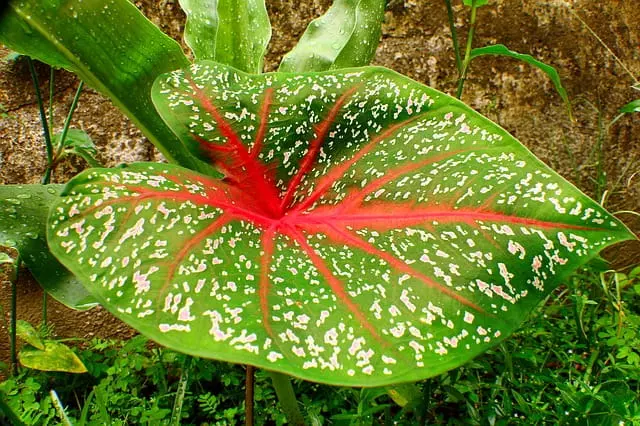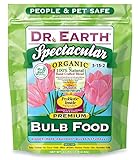Caladium is a beautiful tropical plant with large leaves full of color. They come mainly from Brazil and Guyana, but also from neighboring regions in South and Central America, where they grow in open areas of the jungle, their natural habitat. They say it is a complicated plant when grown as a houseplant, but, with proper care, it is not an impossible mission. Learn all about how to care for Caladium in this article.
Table of Contents
Characteristics of Caladium
The Caladium is an herbaceous plant, with deciduous leaves that come out at the end of stems that grow directly from the tuber underground. They can reach up to 12” (30 cm) in height and have a very varied coloring where cream, pink and red tones stand out on a green background. In total, up to twelve species can be found, but the Caladium bicolor has more than 1000 different variations of shades. Although the plant produces flowers, they are not its main attraction, and it is difficult for them to appear outside its natural habitat.
Caladium can be grown as a houseplant in places where the temperature is kept high and there is plenty of humidity. It can feel at ease in a greenhouse or a gallery dedicated to the collection of plants, where the environment is optimal, but in a living room or other room in our house is somewhat more complicated and requires quite a bit of attention.
I do not want to forget to say that, because of the shape of the leaves and their considerable size (up to 6” and 18” (15 and 45 cm long and wide, respectively) Caladium is popularly known as “angel wings” and “elephant ear”. If you look at the shape of the foliage it may remind you of an Alocasia or a Syngonium, plants to which it is related within the Araceae family.
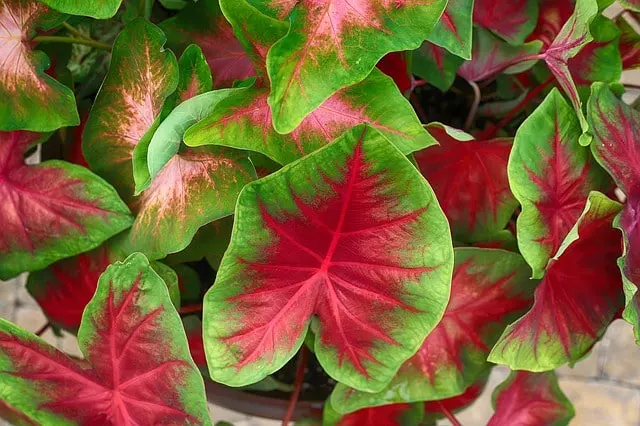
How to Care for Caladium
As with all plants in the Araceae family, Caladium is not recommended for homes with small children or pets. All parts of the plant are toxic. Now we will explain how to care for Caladium.
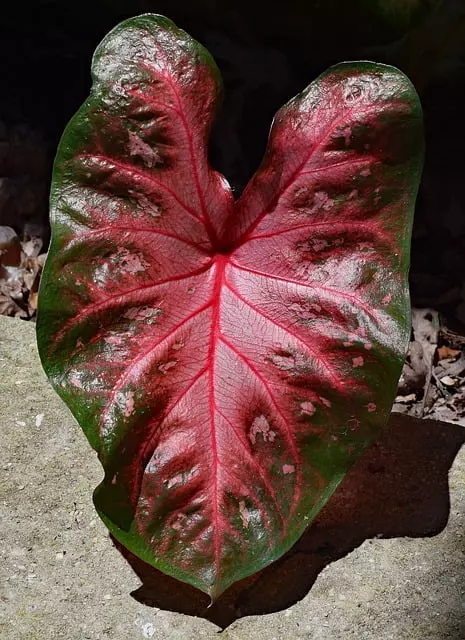
Care for Caladium – Soil
Choose a light and water permeable soil for the caladium. You should use a commercial mix specifically for bulbs and tubers to which you will add moss to improve the structure.
Caladium prefers a small container, but deep enough. Select its size according to the size of the tuber, adding up to 1.5” (4 cm) more in diameter at most.
We recommend this soil for the care of Caladium (Order it here). We have tested it on our indoor plants and it works great.
- Growing indoors is easy under the right conditions; Miracle-Gro Houseplant Potting Mix combines key elements plants need to thrive
- Recommended for growing beautiful indoor houseplant varieties like Pothos, Spider Plants, Monstera, Philodendron, English Ivy and more
- This indoor plant soil is less prone to gnats, thanks to the combination of perlite, sphagnum and peat moss that's just right
Care for Caladium – Location
Caladiums thrive in warm climates, so do what you can to simulate that condition. They need an average temperature of at least 65º F (18º C), but avoid placing them near air conditioners or heat radiators because they are very sensitive.
Since they grow best in humidity, damp places such as the bathroom or kitchen are good for them. They will also do better if grouped with other plants to increase humidity levels around them.
A tray of pebbles or gravel can also be useful: fill a saucer large enough to hold the pot with pebbles and a little water.
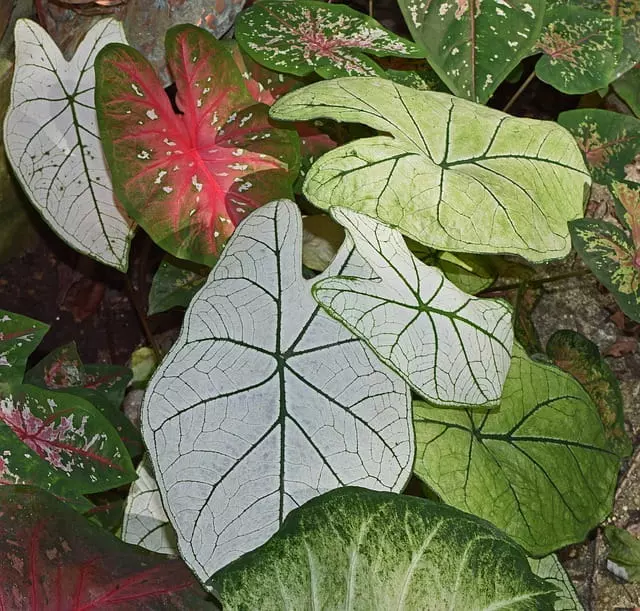
Care for Caladium – Watering
For the correct care of Caladium, we must keep the soil moist but not waterlogged. Water whenever you feel the top of the soil dry. Pour water into the pot until it runs out of the drainage holes, let it drain a little, and then pour more. If you use a saucer or pot cover, drain the excess water to prevent the root from staying wet too long and rotting. You should try never to splash the Caladium leaves.
Care for Caladium – Humidity
Although Caladium needs humidity in its environment, its leaves are very sensitive to water. It is not advisable to spray water on them. The best options are: place it in a room with high humidity, group it with other plants, or put a dish with gravel and water under the pot.
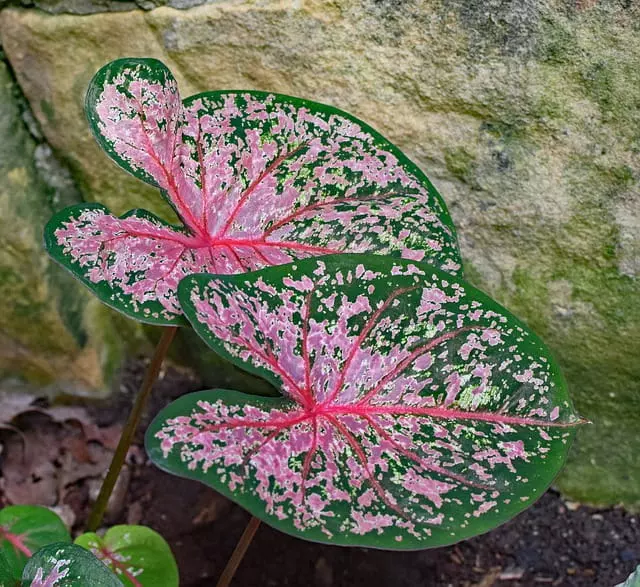
Care for Caladium – Light
Caladium is a plant that needs a lot of light. Some species can withstand direct sun, but it is best to avoid it. Put it near a window that provides bright light and keep the sunlight off it. I have plants in front of a south-facing window and I keep the sun from hitting it by drawing the curtains when direct rays come in. It works well.
Care for Caladium – Fertilizer
Fertilizing this plant is done only during the growing period. The frequency and period of fertilization are simple: wait until the plant fully unfolds the first leaf before the first application of feed. During the first weeks, the plant has sufficient nutrient reserves. After this first application fertilizes regularly every 15 days.
With Caladium, you should use two types of commercial fertilizers: fertilizer for bulbous and tuberous plants or fertilizer for deciduous ornamentals. But whenever possible use organic food with all your plants: worm humus is, in particular, a good nutrient for this species and it is always advisable to alternate it with chemical fertilizers. Excellent fertilizer for the care of Caladium (Order it here).
- 100% organic and natural hand crafted blend
- Includes a target pH of 6.5
- Available in a 4 pound size
Caladium Dormancy Period
If you have been properly caring for your Caladium and the leaves begin to dry and fall off, don’t worry. Caladium is a tuberous plant, it grows from a tuber and this needs a resting period each year. Once all the leaves have dried, remove them from the tuber and let them overwinter somewhere warm. You should keep it in the pot if you put it somewhere where the temperature does not drop below 60º F (15º C), and water it lightly once a month. It can also be dug up, left to dry, and stored in a warm, dry place during the winter. You can replant in the spring and the Caladium will be reborn year after year.
Don’t cut the leaves when they start to wilt, let them dry out completely. As with bulbs, the Caladium tuber absorbs nutrients from the leaves. When they begin to decay before the resting period, wait until they dry out.
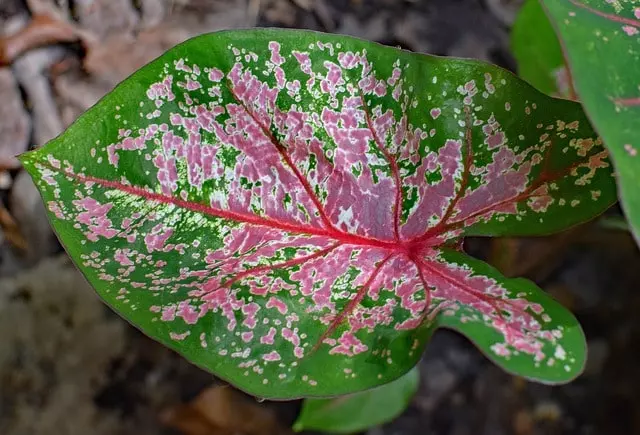
How to Propagate Caladium
Propagation of Caladium is carried out by dividing the tubers. To propagate Caladium, you need to divide the tubers in the spring. If you take them out of the pot in winter, you can use this time to divide them. They should be stored in a dry, warm room at around 68°F (20°C).
Loosen the soil surrounding the plant until the tuber emerges. Brush off any adhering dirt and trim all dead or damaged foliage with scissors. Inspect the tuber and remove any damaged or rotten buds. Sprinkle with a fungicide to prevent infection on healthy tubers.
Select healthy tubers to replant for the new season. Each tuber has several shoots surrounding a larger central one. To encourage more shoots to grow and get more foliage, use a sharp knife to gently cut and lift the central shoot. This encourages smaller shoots to be produced and leads to a fuller, leafier plant.
